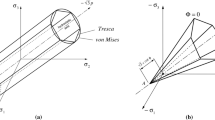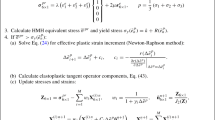Abstract
The Flory’s decomposition is an important mathematical tool used to write hyperelastic constitutive models. As far as the author’s knowledge goes, it has not been used to write plastic flow directions in elastoplastic models and this study is an opportunity to introduce this simple strategy in so important subject. Adopting this decomposition it is possible to write an alternative total Lagrangian elastoplastic framework for finite strains with simple implementation and good response. Using Flory’s decomposition, strains are split into one volumetric and two isochoric parts. The volumetric part is considered elastic along all strain range and isochoric parts are treated as elastoplastic, i.e., the isochoric plastic flow direction is directly defined by the Flory’s decomposition. Assuming this plastic flow direction it is not necessary to employ the classical Kröner-Lee multiplicative decomposition to consider elastic and plastic parts of finite strains. The proposed model is implemented in a 3D geometrical nonlinear positional FEM code and results are compared with literature experimental and numerical data for validation purposes and applications.
































Similar content being viewed by others
References
Wallin M, Ristinmaa M, Ottosen NS (2003) Kinematic hardening in large strain plasticity. Europ J Mech A Solids 22:341–356
Zhang M, Montán FJ (2019) A simple formulation for large-strain cyclic hyperelasto-plasticity using elastic correctors. Theory and algorithmic implementation. Int J Plast 113:185–217
Brepols T, Vladimirov IN, Reese S (2014) Numerical comparison of isotropic hypo- and hyperelastic-based plasticity models with application to industrial forming processes. Int J Plast 63:18–48
Coda HB, Sanches RAK, Paccola RR (2020) Alternative multiscale material and structures modeling by the finite-element method. Eng Comput. https://doi.org/10.1007/s00366-020-01148-y
Abraham FF, Walkup R, Gao H, Duchaineau M, Diaz De La Rubia T, Seager M (2002) Simulating materials failure by using up to one billion atoms and the world’s fastest computer: brittle Fracture. Proc Natl Acad Sci 99:5777–6578
Buehler MJ, Hartmaier A, Gao H, Duchaineau M, Abraham FF (2004) Atomic plasticity: description and analysis of a one-billion atom simulation of ductile materials failure. Comput Methods Appl Mech Engrg 193:5257–5282
Argyris JH, Kleiber M (1977) Incremental formulation in nonlinear mechanics and large strain elasto-plasticity—natural approach. Part 1 Comput Methods Appl Mech Eng 11(2):215–247
Atluri SN (1984) On constitutive relations at finite strain: hypo-elasticity and elasto-plasticity with isotropic or kinematic hardening. Comput Methods Appl Mech Eng 43(2):137–171
Hughes TJR, Winget J (1980) Finite rotation effects in numerical integration of rate constitutive equations arising in large-deformation analysis. Int J Numer Methods Eng 15(12):1862–1867
Kojic M, Bathe KJ (1987) Studies of finite element procedures—stress solution of a closed elastic strain path with stretching and shearing using the updated Lagrangian Jaumann formulation. Comput Struct 26(1–2):175–179
Bruhns OT, Xiao H, Meyers A (1999) Self-consistent Eulerian rate type elasto-plasticity models based upon the logarithmic stress rate. Int J Plasticity 15(5):479–520
Kröner E (1960) Allgemeine kontinuumstheorie der versetzungen und eigenspannungen. Arch Ration Mech Anal 4:273–334
Lee EH (1969) Elastic–plastic deformations at finite strains. J Appl Mech (ASME) 36:1–6
Mandel J (1971) Plasticite classique et viscoplasticity. In: CISM Course 97, Springer-Verlag, Udine
Simo J, Ortiz M (1985) A unified approach to finite deformation elastoplastic analysis based on the use of hyperelastic constitutive equations. Comput Methods Appl Mech Eng 49:221–245
Weber G, Anand L (1990) Finite deformation constitutive equations and a time integration procedure for isotropic, hyperelastic-viscoplastic solids. Comput Methods Appl Mech Eng 79:173–202
Eterovic AL, Bathe KJ (1990) A hyperelastic-based large strain elasto-plastic constitutive formulation with combined isotropic-kinematic hardening using the logarithmic stress and strain measures. Int J Numer Methods Eng 30:1099–1114
Simo JC (1992) Algorithms for static and dynamic multiplicative plasticity that preserve the classical return mapping schemes of the infinitesimal theory. Comput Methods Appl Mech Eng 99:61–112
Weissman SL, Sackman JL (2011) Elastic–plastic multiplicative decomposition with a stressed intermediate configuration. Comput Methods Appl Mech Eng 200(13–16):1607–1618
Simo JC, Ju JW (1989) On continuum damage-elastoplasticity at finite strains. Comput Mech 5(5):375–400
Driemeier L, Comi C, Proenca SPB (2005) On nonlocal regularization in one dimensional finite strain elasticity and plasticity. Comput Mech 36(1):34–44
Li Z, Bloomfield MO, Oberai AA (2018) Simulation of finite-strain inelastic phenomena governed by creep and plasticity. Comput Mech 62(3):323–345
Schroder J, GruttmannLoblein F (2002) A simple orthotropic finite elasto-plasticity model based on generalized stress-strain measures. Comput Mech 30(1):48–64
Areias PMA, Ritto-CorreaMartins MJAC (2010) Finite strain plasticity, the stress condition and a complete shell model. Comp Mech 45(2–3):189–209
Flory PJ (1961) Thermodynamic relations for high elastic materials. Trans Faraday Soc 57:829–838
Ogden RW (1984) Nonlinear Elastic deformation. Ellis Horwood, England
Pascon JP, Coda HB (2015) Large deformation analysis of functionally graded elastoplastic materials via solid tetrahedral finite elements. Comput Struct 146:59–75
Carrazedo R, Paccola RR, Coda HB (2018) Active face prismatic positional finite element for linear and geometrically nonlinear analysis of honeycomb sandwich plates and shells. Compos Struct 200:849–863
Coda HB, Paccola RR (2007) An alternative positional FEM formulation for geometrically non-linear analysis of shells: Curved triangular isoparametric elements. Comput Mech 40(1):185–200
Rivlin R, Saunders D (1951) Large elastic deformations of isotropic materials VII. Experiments on the deformation of rubber. Philos Trans R Soc Lond Ser A 243:251–288
Düster A, Hartmann S, Rank E (2003) p-FEM applied to finite isotropic hyperelastic bodies. Comput Methods Appl Mech Eng 192:5147–5166
Botta AS, Paccola RR, Venturini WS, Coda HB (2008) A discussion on volume change in the plastic phase. Commun Numer Methods Eng 24(11):1149–1162
Jones RM (2009) Deformation theory of plasticity. books.google.com
Bridgman PW, Bell G (1949) The physics of high pressure. London
Norris DM, Moran B, Scudder JK, Quinones DF (1978) A computer simulation of the tension test. J Mech Phys Solids 26:1–19
Merston TU, Boroen MP, Fox JH, Reardon LD (1975) Fracture Toughness of Ferritic Materials in Light Water Nuclear Reactor Vessels. Rep. no. EPRI 232–2. Electric Power Research Institute, Palo Alto, CA
Eidel B, Gruttmann F (2003) Elastoplastic orthotropy at finite strains: multiplicative formulation and numerical implementation. Comput Mater Sci 28:732–742
Simo JC, Armero F (1992) Geometrically nonlinear enhanced strain mixed methods and the method of incompatible modes. Int J Numer Methods Eng 33:1413–1449
Koissin V, Shipsha A, Rizov V (2004) The inelastic quasi-static response of sandwich structures to local loading. Compos Struct 64(2):129–138
Wang P, Chalal H, Abed-Meraim F (2017) Quadratic solid–shell elements for nonlinear structural analysis and sheet metal forming simulation. Comput Mech 59:161–186
Betsch P, Stein E (1999) Numerical implementation of multiplicative elasto-plasticity into assumed strain elements with application to shells at large strains. Comput Methods Appl Mech Eng 179:215–245
Fontes Valente RA, Alves de Sousa RJ, Natal Jorge RM (2004) An enhanced strain 3D element for large deformation elastoplastic thin-shell applications. Comput Mech 34:38–52
Wriggers P, Eberlein R, Reese S (1996) A comparison of threedimensional continuum and shell elements for finite plasticity. Int J Solids Struct 33:3309–3326
Eberlein R, Wriggers P (1999) Finite element concepts for finite elastoplastic strains and isotropic stress response in shells: theoretical and computational analysis. Comput Methods Appl Mech Eng 171:243–279
Acknowledgements
This research has been supported by the São Paulo Research Foundation, Brazil—Grant #2020/05393–4.
Author information
Authors and Affiliations
Corresponding author
Additional information
Publisher's Note
Springer Nature remains neutral with regard to jurisdictional claims in published maps and institutional affiliations.
Appendices
Appendix A
1.1 Second Piola–Kirchhoff stress components
In order to be complete, this appendix shows that the second Piola–Kirchhoff stress components \(\left( {{\varvec{S}}^{J} ,{\varvec{S}}^{1} ,{\varvec{S}}^{2} } \right)\) defined by Eq. (12) are related, respectively, to the hydrostatic and deviatoric Cauchy stress components \(\left( {{\varvec{\sigma}}_{{}}^{vol} ,{\varvec{\sigma}}^{iso1} ,{\varvec{\sigma}}^{iso2} } \right)\). This is done applying the well known relation among the second Piola-Kirchhof stress and the Cauchy stress, as follows:
To make operation simple one starts rewriting Eq. (11) in a general form:
So, for each component one writes:
-
Volumetric
The candidate to volumetric component of the second Piola Kirchhoff stress is written as:
In which \(\alpha\) is a scalar and
Applying Eq. (55) over the second Piola–Kirchhoff stress of Eq. (57) results:
which means that \({\mathfrak{E}}^{J}\) is the Lagrangian strain direction corresponding to the hydrostatic stress in the Cauchy space and that \({\varvec{A}}^{J}\) is hydrostatic in Lagrangian sense.
-
First isochoric
The candidate to first isochoric component of the second Piola–Kirchhoff stress is written as:
where \(\beta\) is a scalar and \(\mathfrak{E}^{1}\) is a symmetric tensor of the same order of the Green strain. It is not usual to see the following expressions, but it is well known and straightforward to show that:
from which one finds:
Considering Eq. (62) and applying the transformation (55) over Eq. (60), results:
And, as
one achieves:
which means that \({\mathfrak{E}}^{1}\) is the first isochoric Lagrangian strain direction and \({\varvec{S}}^{1}\) is the first isochoric second Piola–Kirchhoff stress.
-
Second isochoric
The candidate to second isochoric component of the second Piola–Kirchhoff stress is written as:
with \(\gamma\) and \({\mathfrak{E}}^{2}\) being respectively a scalar and a symmetric tensor of the same order as the Green–Lagrange strain tensor. It is interesting to write:
in which \(I_{2}\) is the second invariant of the Cauchy stretch. With some algebraic effort, over Eq. (68), results:
Using Eq. (55) over Eq. (67) and considering Eq. (69), one writes:
Using equation (70) results:
From Eq. (71) one calculates \(Tr\left( {\sigma^{iso2} } \right)\) as
thus:
meaning that \({\mathfrak{E}}^{2}\) is the second isochoric Lagrangian strain direction and \({\varvec{S}}^{2}\) is the second isochoric component of the second Piola–Kirchhoff stress.
Appendix B
2.1 Axial test and stress limits
In a simple axial test (following direction \(x_{1}\)) for a quasi isochoric material one writes:
In which \(\lambda_{i}\) are stretches in direction \(i\). Considering isotropy, for this test one writes \(\lambda_{2} = \lambda_{3} = \lambda\) and, from (73) one assumes:
Making some algebraic simple steps one achieves from Eqs. (13) and (14):
and
Thus, using Eq. (12), the following particular relation is achieved for very small volume change in elastic situation and simple axial stretch:
For metallic materials it is expected that the yielding starts in the interval \(0.001 < \lambda_{1} - 1 < 0.003\). From this reasoning it is fair to split the von-Mises criterion given by Eq. (18) into two expressions given in Eq. (19) with \(\overline{\tau }^{1} = \overline{\tau }^{2} = \overline{\tau }\). If finite elastic strain is present and \(G^{1}\) is different from \(G^{2}\), than \(\overline{\tau }_{i}\) can be calibrated accordingly.
Appendix C
In this appendix two tables referred to example 1 are presented in order to simplify graphical reproduction (Tables 2 and 3).
Rights and permissions
About this article
Cite this article
Coda, H.B. A finite strain elastoplastic model based on Flory’s decomposition and 3D FEM applications. Comput Mech 69, 245–266 (2022). https://doi.org/10.1007/s00466-021-02092-4
Received:
Accepted:
Published:
Issue Date:
DOI: https://doi.org/10.1007/s00466-021-02092-4




